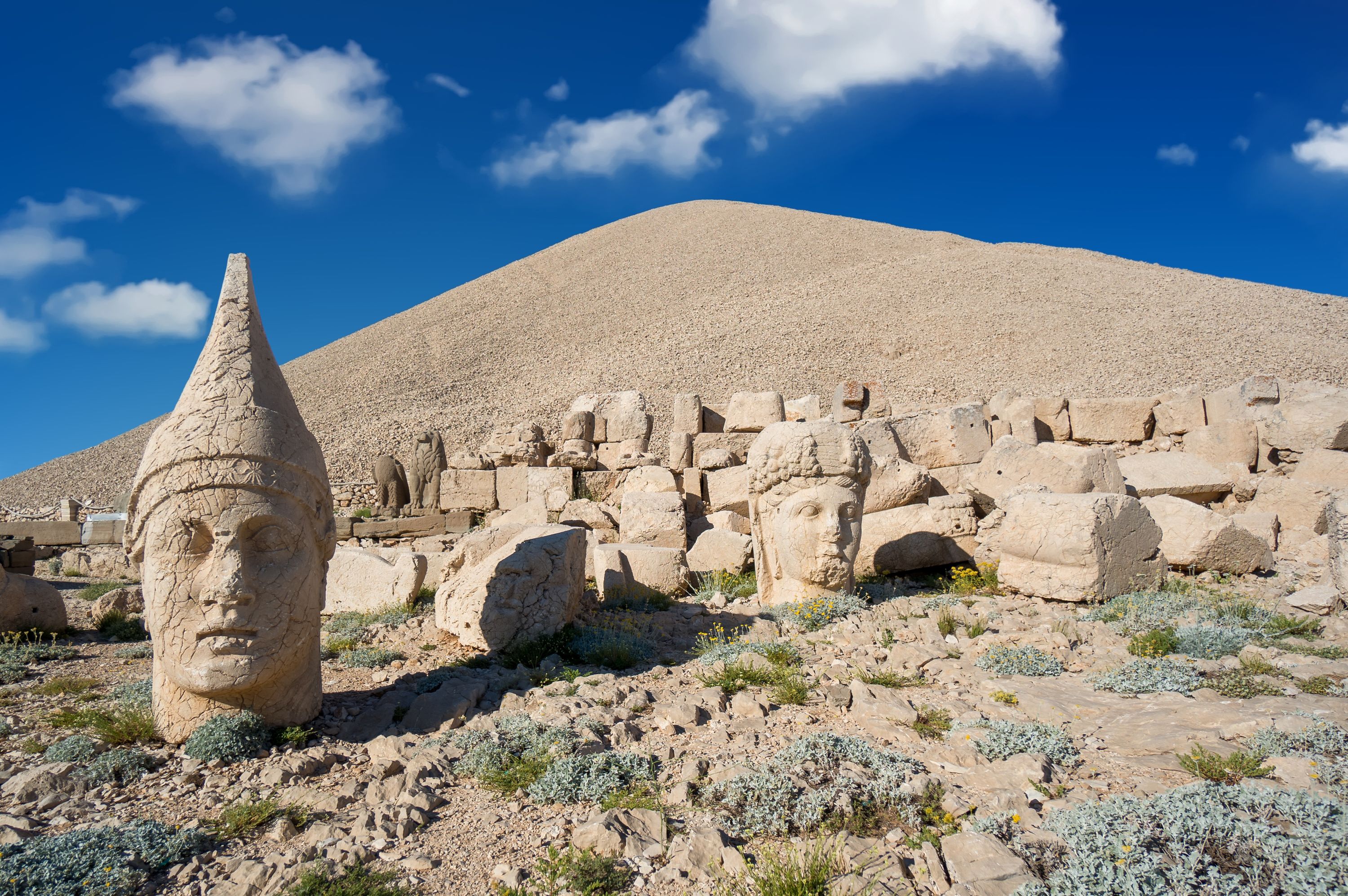Mount Nemrut, located in the rugged highlands of Adıyaman, Turkey, stands as one of the most extraordinary and enduring legacies of the Hellenistic period. Home to the grand mausoleum of Antiochus I (69–34 BC), the site is a testament to the ambition of a ruler who sought to merge East and West through monumental architecture and a fusion of religious traditions. The kingdom of Commagene, ruled by Antiochus, flourished in the centuries following the fragmentation of Alexander the Great’s empire, and Mount Nemrut became the symbol of his power, vision, and divinity.
The Kingdom of Commagene: A Melting Pot of Cultures
The kingdom of Commagene, located between the Roman and Persian empires, was an eclectic blend of Greek, Persian, and local traditions. Antiochus I ascended to the throne in the 1st century BC and played a crucial role in establishing Commagene as a cultural and political bridge between two of the ancient world’s most powerful forces. This blending of cultures is most evident in the architecture and statues of Mount Nemrut, which combine elements of both Greek and Eastern iconography.

Antiochus I positioned himself not only as a king but as a divine figure, integrating elements of Hellenistic and Persian religions to affirm his supreme status. This ambition is reflected in the remarkable monument he commissioned on the summit of Mount Nemrut, which would ensure his legacy as a ruler who transcended earthly kingship to achieve divine status.
The Colossal Statues of Mount Nemrut
The most striking feature of Mount Nemrut is its colossal statues, which were constructed to honor Antiochus I and his divine associates. The site is famous for its large stone heads, remnants of colossal statues that once stood proudly around the mountaintop. These statues include representations of Greek gods like Apollo, Zeus, and Heracles, alongside the likenesses of Antiochus himself, emphasizing his self-deification. Each figure is seated, with their eyes looking outwards, creating a sense of power and control over the surrounding landscape.

The monumental burial mound at the peak of the mountain is believed to house the remains of Antiochus I, though the tomb remains unopened and its contents a mystery. The statues surrounding this burial mound were arranged to face the cardinal directions, ensuring that Antiochus I’s divine presence would be felt from every corner of the kingdom. The heads, many of which have survived the ravages of time and natural disasters, still stand as a silent testament to his ambition.
The Engineering Feat Behind Mount Nemrut
Constructing the monumental statues and the burial mound at such a high altitude required an extraordinary feat of engineering. Massive stone blocks were transported to the summit of Mount Nemrut, with each statue and relief carefully designed and placed. The sheer scale of this undertaking highlights the resources and manpower available to Antiochus I and reflects his desire to leave an indelible mark on history.

The site is also an example of architectural ingenuity, with the statues and reliefs carefully arranged to create a harmonious blend of Hellenistic and Persian styles. The monument was designed to honor both Greek gods and Persian deities, reflecting Antiochus’s vision of cultural unity and his efforts to reconcile differing traditions in a single monumental expression of power.
Mount Nemrut as a Symbol of Divine Kingship
Mount Nemrut was not just a tomb or a place of worship—it was a symbol of Antiochus I’s divine kingship. The king’s desire to be revered as a god is evident in the integration of both Hellenistic and Eastern religious motifs. The blending of Greek and Persian iconography on the statues represents Antiochus’s position as a ruler who could bridge the gap between two worlds and command the respect of both cultures.

The mountain itself was not only an architectural triumph but also a representation of Antiochus’s enduring legacy. The layout of the statues, arranged in a way that would have been visible from great distances, ensured that his image would be ingrained in the minds of his subjects for generations to come. The sheer grandeur of the monument served as a powerful statement of Antiochus I’s ambition, demonstrating his belief in his own divine authority and his desire to ensure that future generations would remember him as both king and god.
Mount Nemrut Today: A UNESCO World Heritage Site
Declared a UNESCO World Heritage Site in 1987, Mount Nemrut remains one of Turkey’s most iconic archaeological sites. Its preservation and continued study have shed light on the ambitious vision of Antiochus I, whose mausoleum continues to inspire awe and curiosity. The site attracts visitors from all over the world, drawn not only by its historical significance but also by the awe-inspiring scale of its architecture and the mystery surrounding Antiochus I’s tomb.

Mount Nemrut stands as a testament to the ambition of Antiochus I—a ruler who sought to achieve divine status through monumental architecture and cultural integration. The site reflects his belief in the power of architecture to immortalize his legacy, blending Greek and Persian influences to create a lasting monument to his reign. Today, it remains a remarkable example of Hellenistic architecture and a symbol of a ruler who bridged the gap between two great civilizations.
Conclusion: A Lasting Legacy of Antiochus I
Mount Nemrut is more than just a mausoleum; it is a powerful expression of Antiochus I’s divine kingship and his vision of cultural unity. The colossal statues, monumental tomb, and the blending of religious iconography on the mountaintop reflect his ambition to ensure that his reign would be remembered for centuries to come. As a UNESCO World Heritage Site, it continues to be a symbol of the ambition and vision of one of history’s most remarkable rulers, whose legacy is immortalized in stone.

